The Kawasaki KLR 650 service manual is a comprehensive guide for maintenance‚ repair‚ and upgrades of this versatile dual-sport motorcycle‚ updated for the 2022 model year.
1.1 Overview of the Kawasaki KLR 650
The Kawasaki KLR 650 is a versatile dual-sport motorcycle designed for both on-road and off-road adventures. Known for its reliability and durability‚ it features a robust 652cc single-cylinder engine‚ making it a favorite among adventure riders and commuters. Its lightweight frame‚ high ground clearance‚ and comfortable ergonomics ensure excellent maneuverability on various terrains. With a reputation for being easy to maintain and modify‚ the KLR 650 has become a popular choice for enthusiasts seeking a balance between performance and practicality. Its fuel efficiency and manageable weight further enhance its appeal.
1.2 Importance of the Service Manual
The Kawasaki KLR 650 service manual is an essential resource for owners and mechanics‚ providing detailed instructions for maintenance‚ repairs‚ and upgrades. It ensures proper servicing‚ preventing costly mistakes and prolonging the bike’s lifespan. The manual contains specifications‚ torque values‚ and diagnostic procedures‚ making it indispensable for DIY enthusiasts and professionals alike. Regularly referencing the manual helps maintain safety‚ performance‚ and reliability‚ while also aiding in troubleshooting common issues specific to the KLR 650 model.

Key Features of the Kawasaki KLR 650
The Kawasaki KLR 650 is a versatile dual-sport motorcycle‚ featuring a 652cc engine‚ 6.1-gallon fuel tank‚ and lightweight design‚ ideal for on-road and off-road adventures‚ known for reliability and durability.
2.1 Engine Specifications
The Kawasaki KLR 650 is powered by a 652cc‚ four-stroke‚ single-cylinder engine with a displacement of 52 x 57.8mm bore and stroke. It features a liquid-cooled system for optimal temperature regulation‚ ensuring reliability in various riding conditions. The engine produces approximately 37 horsepower at 6‚000 rpm and 32 lb-ft of torque at 4‚800 rpm‚ providing a balance of power and versatility. Equipped with a four-valve DOHC configuration and digital fuel injection‚ the KLR 650 delivers smooth throttle response and efficient fuel consumption‚ making it suitable for both on-road and off-road adventures.
2.2 Transmission and Drivetrain
The Kawasaki KLR 650 features a 6-speed manual transmission‚ offering smooth shifting and a wide gear range for diverse riding conditions. The drivetrain utilizes a 520-series sealed chain‚ known for its durability and minimal maintenance requirements. The final drive ratio of 2;47:1 provides a balance between low-end torque for off-road maneuverability and high-speed cruising on paved roads. This setup ensures efficient power delivery‚ making the KLR 650 versatile for both on-road commuting and off-road adventures‚ while maintaining reliability and performance across various terrains.
2.3 Suspension and Handling
The Kawasaki KLR 650 is equipped with a robust suspension system designed for both on-road and off-road performance. The front features a 38mm telescopic fork with 7.9 inches of travel‚ while the rear utilizes a Uni-Trak monoshock with 7.3 inches of travel‚ providing excellent damping and stability. The suspension is adjustable‚ allowing riders to fine-tune settings for load or terrain. This setup ensures a smooth ride on paved roads and confident handling on rough trails‚ making the KLR 650 highly versatile for adventure riding and commuting alike.
2.4 Braking System
The Kawasaki KLR 650 features a reliable braking system designed for both on-road and off-road use. The front wheel is equipped with a 280mm single rotor and a dual-piston caliper‚ while the rear wheel has a 240mm rotor with a single-piston caliper. The system provides consistent stopping power and control‚ even in challenging conditions. The brake master cylinder ensures precise modulation‚ and the brake lines are designed for durability. Regular maintenance‚ such as replacing brake pads and inspecting rotors‚ is essential for optimal performance and safety.
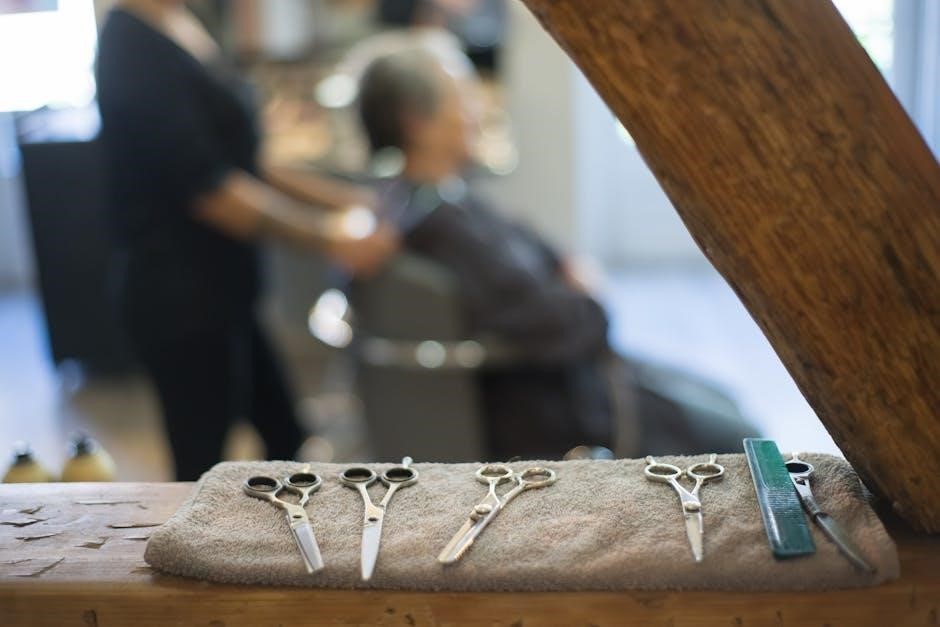
Maintenance Schedule
Regular maintenance is crucial for optimal performance and longevity. The schedule includes oil changes‚ tire pressure checks‚ chain lubrication‚ and filter replacements. Adhering to these intervals ensures the KLR 650 runs smoothly and prevents potential issues. Following the manual’s guidelines helps maintain reliability and safety.
3.1 Routine Maintenance Tasks
Routine maintenance tasks for the Kawasaki KLR 650 include checking and cleaning the air filter‚ inspecting the chain or belt drive‚ and ensuring proper tension. Brake pads should be examined for wear‚ and all bolts and fasteners must be tightened to specified torque values. Electrical connections should be cleaned and secured‚ and the coolant level must be checked regularly. These tasks ensure reliable performance‚ prevent mechanical failures‚ and maintain safety. Always follow the intervals outlined in the service manual for consistent upkeep.
3.2 Oil Change and Lubrication
Regular oil changes are essential for maintaining the Kawasaki KLR 650’s engine health. Use the specified 10W-40 synthetic oil and a high-quality filter. Drain the old oil into a pan‚ replace the filter‚ and refill with the recommended oil volume. Tighten the drain plug to the torque specification. Lubricate the chain or belt drive according to the manual’s guidelines. Perform this service every 2‚500 to 3‚000 miles to ensure optimal engine performance and longevity. Proper disposal of used oil and filters is environmentally responsible.
3.3 Tire Care and Pressure Checks
Regular tire care is crucial for safety and performance. Check tire pressure monthly and before long trips‚ using the recommended pressures (33-36 PSI front‚ 36-40 PSI rear‚ loaded). Inspect tires for wear‚ cracks‚ or punctures. Maintain proper tread depth (at least 1/16 of an inch). Clean tires with mild soap and water to prevent damage from dirt and grime. Always refer to the Kawasaki KLR 650 service manual for specific guidelines to ensure optimal tire condition and safe riding.
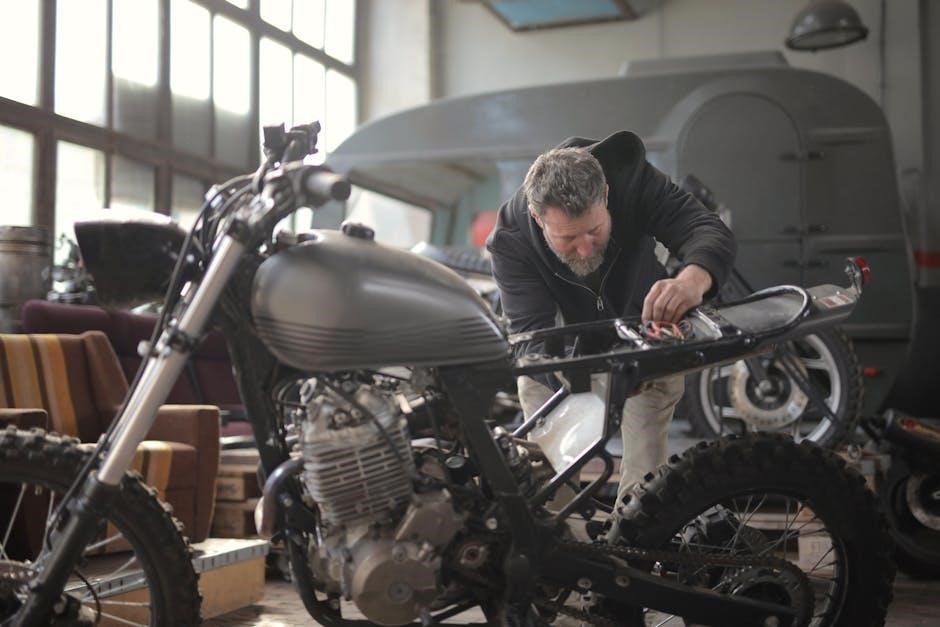
Engine Service and Repair
The Kawasaki KLR 650 features a 652cc four-stroke‚ single-cylinder‚ DOHC‚ liquid-cooled engine. Regular service includes air filter cleaning‚ spark plug replacement‚ and engine component inspections. Follow the service manual for optimal performance and longevity.
4.1 Engine Overview and Components
The Kawasaki KLR 650 is powered by a 652cc‚ four-stroke‚ single-cylinder‚ DOHC‚ liquid-cooled engine. Key components include the cylinder head‚ piston‚ crankshaft‚ camshaft‚ and valves. The engine features a counterbalance shaft to reduce vibration‚ enhancing rider comfort. The fuel system includes a carburetor (in earlier models) or fuel injection (in newer models)‚ ensuring efficient combustion. Proper maintenance of these components is essential for optimal performance and longevity. Refer to the service manual for detailed specifications and procedures to ensure accurate servicing and repair of the engine.
4.2 Oil and Filter Replacement
Regular oil and filter changes are crucial for maintaining the Kawasaki KLR 650’s engine health. Use a high-quality 10W-40 motorcycle oil and a genuine Kawasaki oil filter (part # 16099-0004). Warm the engine‚ drain the old oil into a pan‚ and replace the filter. Refill with the recommended oil capacity (approximately 2.6 quarts). Tighten the drain plug to the specified torque (30 Nm). Dispose of used oil and filters responsibly. Always reset the service indicator after completion for accurate maintenance tracking.
4.3 Cylinder Head Maintenance
Cylinder head maintenance is essential for ensuring optimal engine performance. Inspect the head for cracks‚ warping‚ or excessive wear. Clean the surface thoroughly and replace the gasket if damaged. Check valve clearances and adjust as specified (0.10-0.15mm for intake‚ 0.15-0.20mm for exhaust). Ensure the spark plug hole is clean and properly torque the spark plug (19 Nm). If issues persist‚ such as oil leaks or reduced compression‚ consider professional servicing. Regular maintenance prevents costly repairs and extends engine life.

Transmission and Drivetrain Service
Regular servicing ensures smooth power delivery. Inspect the gearbox‚ final drive‚ and chain for wear. Lubricate components and replace the chain when stretched or worn. Perform periodic inspections and adjust chain tension for optimal performance. Address any unusual noises or slippage promptly to prevent damage. Proper maintenance extends the lifespan of the drivetrain and enhances overall motorcycle reliability. Always refer to the manual for torque specifications and adjustment procedures.
5.1 Transmission Overview
The Kawasaki KLR 650 features a 6-speed‚ constant-mesh transmission designed for smooth power delivery across various terrains. The gearbox includes a dual-range subtransmission‚ enhancing low-speed maneuverability and high-speed cruising efficiency. The transmission is durable and reliable‚ with well-spaced gear ratios to suit both on-road and off-road conditions. Regular maintenance‚ such as lubrication and inspection‚ ensures optimal performance. The manual provides detailed procedures for transmission fluid replacement and adjustment to maintain precise shifting and overall drivetrain functionality. Proper care extends the lifespan of the transmission and ensures reliable operation;
5.2 Chain or Belt Replacement
The Kawasaki KLR 650 uses a durable chain drive system‚ requiring periodic inspection and replacement. Chains wear over time‚ affecting performance and potentially damaging other components. The service manual outlines steps for chain replacement‚ including measuring wear‚ cleaning‚ and lubrication. Proper tension adjustment is critical to prevent premature wear and maintain smooth power delivery. Always use a high-quality chain meeting Kawasaki specifications. Replacement involves removing the old chain‚ fitting the new one‚ and ensuring correct alignment. Tools like a chain breaker and rivet tool are essential for a secure installation.
5.3 Drivetrain Lubrication
Regular drivetrain lubrication is essential for optimal performance and longevity. The Kawasaki KLR 650’s chain drive requires high-quality chain lube to prevent wear and corrosion. Apply lubricant evenly‚ ensuring all links are coated. Clean the chain thoroughly before application to remove dirt and grime. Excessive lubrication should be avoided to prevent attracting debris. Follow the service manual’s guidelines for frequency and product recommendations to maintain your bike’s drivetrain in top condition. Proper lubrication enhances performance and extends component life.

Suspension and Steering Maintenance
Regular inspection of suspension and steering components is crucial. Lubricate all moving parts to prevent corrosion and ensure smooth operation. Follow the manual’s guidelines for optimal performance.
6.1 Suspension Components Overview
The Kawasaki KLR 650 features a robust suspension system designed for both on-road and off-road performance. The front suspension consists of a telescopic fork with damping and spring functions‚ while the rear suspension includes a Uni-Trak linkage system with a shock absorber. These components work together to provide stability‚ control‚ and comfort by absorbing bumps and maintaining tire contact with the ground. Regular inspection and maintenance of these parts are essential to ensure optimal handling and safety. Always refer to the service manual for specific guidelines on inspection and adjustment.
6.2 Adjusting Suspension Settings
Adjusting the suspension settings on the Kawasaki KLR 650 ensures optimal performance for various riding conditions. The front fork allows for preload adjustment using a specialized tool‚ while the rear shock absorber features a preload adjuster and rebound damping settings. Riders can fine-tune these settings based on their weight‚ cargo‚ and terrain. Proper adjustment enhances stability‚ control‚ and comfort. Always refer to the service manual for detailed instructions and torque specifications to avoid over- or under-tightening components‚ which could compromise safety and handling.
6.3 Replacing Fork Seals and Shock Absorbers
Replacing fork seals and shock absorbers on the Kawasaki KLR 650 requires care to ensure proper function. Start by disassembling the fork‚ removing the fork tube and spring. Use a fork seal driver to remove the old seals and install new ones. For the shock absorber‚ remove the preload spacer and spring‚ then replace the worn or leaking components; Clean all parts thoroughly before reassembly. Properly tighten all components using the torque specifications in the service manual to restore optimal suspension performance and prevent further damage.
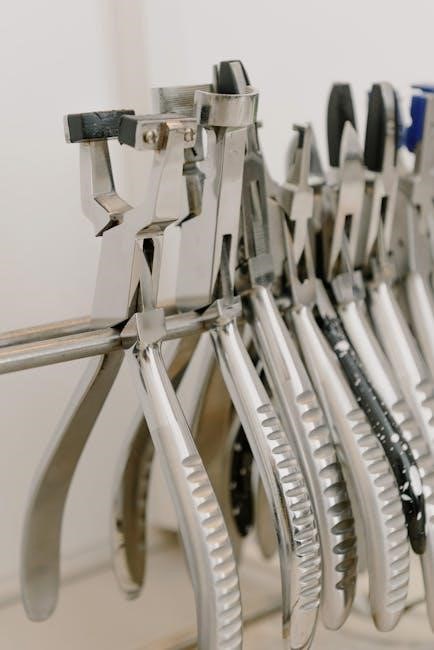
Brake System Service
This section covers essential maintenance‚ inspection‚ and repair procedures for the KLR 650’s braking system‚ ensuring safe and reliable stopping power. Key components include brake calipers‚ master cylinders‚ and brake fluid systems. Proper servicing involves checking pad wear‚ bleeding brakes‚ and maintaining rotor condition. Always follow torque specifications and safety guidelines for optimal performance and rider safety.
7.1 Brake Components Overview
The Kawasaki KLR 650’s braking system consists of front and rear components essential for safe stopping. The front features a dual-piston caliper with a large rotor‚ while the rear has a single-piston caliper. Brake pads are crucial for friction‚ and rotors dissipate heat. The master cylinder converts lever input into hydraulic pressure‚ and the brake fluid system ensures consistent performance. Regular inspection of these components is vital for maintaining reliable braking. This integrated system ensures control and safety during riding.
7.2 Replacing Brake Pads
Replacing brake pads on the Kawasaki KLR 650 is a straightforward process. Start by gathering tools like a C-clamp‚ new brake pads‚ and a clean workspace. Remove the caliper bolts and slide off the caliper‚ taking care not to damage the brake hose. Extract the old pads and inspect the rotor for wear. Install the new pads‚ ensuring proper alignment. Reattach the caliper and tighten the bolts. Use the C-clamp to compress the piston before test-braking. Always follow the service manual’s torque specifications for safety and reliability.
7.3 Maintaining Brake Rotors
Maintaining the brake rotors on your Kawasaki KLR 650 is crucial for optimal braking performance. Inspect the rotors regularly for excessive wear‚ scoring‚ or warping. Clean them with a soft cloth and brake cleaner to remove dirt and oil residue. Use a rotor gauge to measure thickness; replace the rotor if it falls below the minimum specification. If warped‚ have the rotor machined or replaced by a professional. Always follow the service manual’s guidelines for proper maintenance and ensure the rotor is securely mounted before riding.
Electrical System Service
The electrical system service involves battery maintenance‚ wiring checks‚ and fuse inspections to ensure reliable performance and prevent electrical failures on the Kawasaki KLR 650.
8.1 Battery Maintenance and Replacement
Regular battery maintenance is crucial for reliable starting and electrical performance. Check the terminals for corrosion and clean them with a wire brush if necessary. Ensure the battery is fully charged using a compatible charger‚ avoiding overcharging. Replace the battery every 3-5 years or when capacity drops below 10-12 V. Always disconnect the negative terminal first for safety. Refer to the Kawasaki KLR 650 service manual for specific torque values and connection procedures to maintain optimal function and prevent electrical system issues.
8.2 Wiring and Electrical Components Check
Inspect the wiring harness for signs of damage‚ wear‚ or corrosion. Check all connections for tightness and cleanliness. Use a multimeter to test for voltage drops or short circuits. Ensure all electrical components‚ such as switches‚ sensors‚ and relays‚ are functioning properly. Refer to the Kawasaki KLR 650 service manual for detailed diagrams and procedures. Regularly cleaning and lubricating connectors can prevent electrical issues. Addressing faults promptly helps maintain reliability and safety. Always follow proper testing procedures to avoid further damage.
8.3 Troubleshooting Electrical Issues
Identify electrical issues by checking for blown fuses or tripped circuit breakers. Inspect connectors for corrosion or damage and clean or replace them as needed. Use a multimeter to test voltage at various points‚ ensuring proper connections. Check the ignition system‚ including coils and spark plugs‚ for faults. Verify the battery charge level and connections. Consult the Kawasaki KLR 650 service manual for wiring diagrams to trace circuits. Addressing electrical problems promptly prevents further damage and ensures reliable operation. Always follow safety guidelines when working with electrical systems.
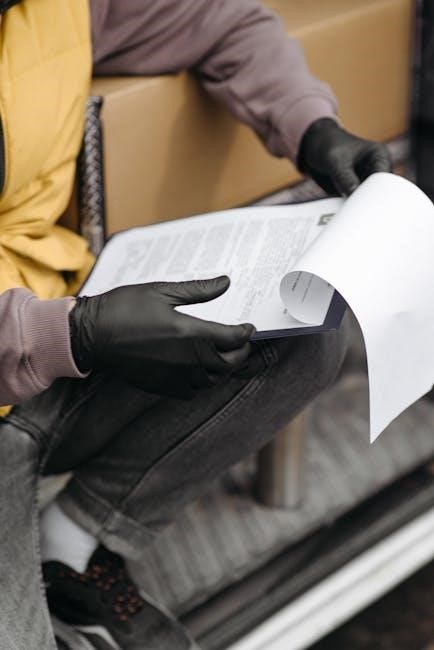
Common Issues and Troubleshooting
The Kawasaki KLR 650 may experience issues like engine stalling or electrical faults. This section guides owners through diagnosing and resolving these common problems effectively.
9.1 Identifying Common Problems
Common issues with the Kawasaki KLR 650 include chain wear‚ suspension sag‚ and exhaust leaks. Riders may also encounter vibrations‚ faulty air filters‚ and electrical connector problems. Early detection of these issues ensures reliable performance and prevents major repairs.
9.2 Diagnostic Techniques
Diagnosing issues on the Kawasaki KLR 650 involves visual inspections‚ sound analysis‚ and systematic testing. Check for wear on chains‚ sprockets‚ and brake pads. Listen for unusual noises‚ such as engine knocks or bearing growls. Use tools like multimeters for electrical system checks. Refer to the service manual for specific diagnostic procedures and troubleshooting charts. Regular inspections help identify potential issues early‚ ensuring reliable performance and extending the bike’s lifespan.
9.3 Solutions for Recurring Issues
Address recurring issues by identifying root causes. For persistent engine knocking‚ inspect valve clearances and adjust or replace as needed. Chain wear can be minimized by ensuring proper tension and lubrication. Electrical faults often require cleaning connections or replacing corroded components. Regularly updating to the latest service manual specifications can resolve recurring problems. Always follow Kawasaki-recommended fixes to maintain reliability and performance‚ ensuring your KLR 650 runs smoothly for years;

Modifications and Upgrades
Popular upgrades include suspension enhancements‚ aftermarket exhaust systems‚ and protective gear like crash bars. Accessory installations like GPS mounts and lighting improve functionality and customization.
10.1 Performance Enhancements
Enhancing performance often involves upgrading the air filter‚ exhaust system‚ and engine tuning. A high-flow air filter improves airflow‚ while an aftermarket exhaust increases horsepower and torque. ECU tuning can further optimize engine performance for specific riding conditions. Additionally‚ lightweight components such as aluminum rims or titanium bolts reduce weight‚ enhancing acceleration and handling. These modifications should be done in conjunction with the service manual to ensure compatibility and avoid voiding the warranty. Always test modifications on a dyno to ensure proper engine calibration and performance gains.
10.2 Suspension Upgrades
Upgrading the suspension can significantly improve handling and comfort. Replacing the stock fork springs with heavier-duty options enhances stability‚ especially for loaded bikes. Installing an aftermarket rear shock with adjustable damping provides better rear-end control. Additionally‚ a steering stabilizer reduces wobble at higher speeds. These upgrades are particularly beneficial for off-road riding or carrying heavy loads. Always follow the service manual’s guidelines for installation and testing to ensure proper function and safety. Properly upgraded suspension transforms the KLR 650’s ride quality and performance.
10.3 Accessory Installation
Installing accessories can enhance functionality and customization. Popular upgrades include skid plates‚ engine guards‚ and luggage racks. For lighting‚ LED auxiliary lights improve visibility. GPS mounts and phone holders add convenience for navigation. When installing‚ ensure proper fitment and compatibility with existing components. Electrical accessories should be wired correctly to avoid system overload. Always consult the service manual for specific installation guidelines. Test all modifications to ensure safety and performance. Properly installed accessories can significantly enhance your KLR 650’s versatility and riding experience‚ whether on-road or off-road.
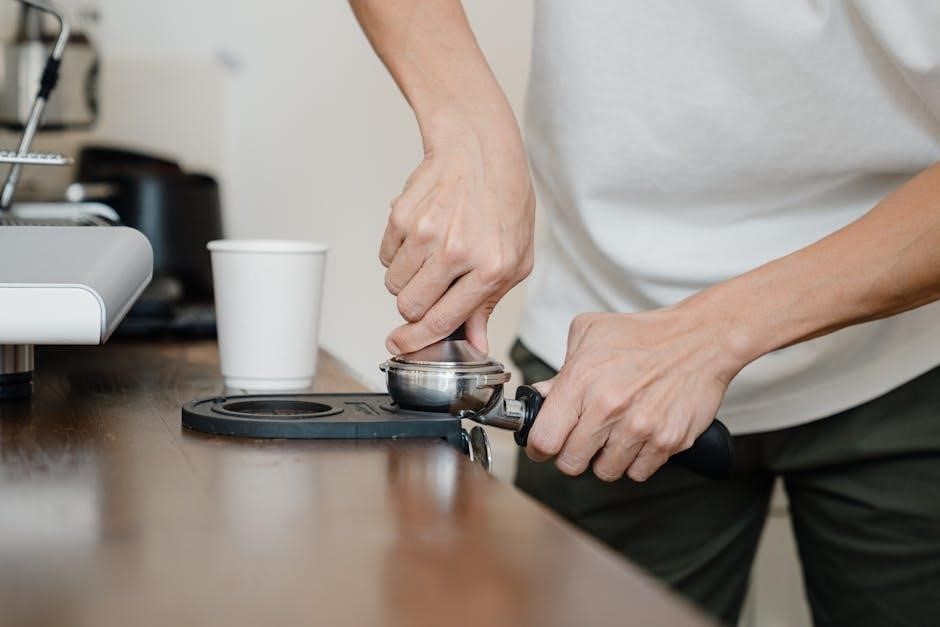
Safety Precautions and Best Practices
Always wear protective gear‚ ensure proper tool usage‚ and follow manual guidelines. Regular inspections and adherence to safety protocols minimize risks. Safe practices enhance riding confidence and bike longevity.
11.1 Safety Gear and Protective Equipment
Safety gear is essential for protecting riders and technicians. Always wear a helmet‚ gloves‚ safety glasses‚ and sturdy footwear when working on or riding the Kawasaki KLR 650. A high-quality helmet protects the head from impact‚ while gloves prevent hand injuries and improve grip. Steel-toe boots safeguard feet and ankles‚ and durable clothing like leather jackets minimizes abrasions. Properly fitting gear ensures comfort and effectiveness. Regularly inspect gear for wear and tear to maintain its protective capabilities. Prioritizing safety gear is crucial for preventing injuries during maintenance and riding.
11.2 Safe Riding Practices
Safe riding practices are crucial for minimizing risks on the Kawasaki KLR 650. Always adjust speed to road conditions‚ use signals‚ and stay alert to surroundings. Maintain a safe distance from other vehicles and avoid distractions like using a phone. Wear proper gear‚ ensure the bike is in good condition‚ and follow traffic laws. Be visible to other drivers by using reflective gear and staying in well-lit areas. Stay focused‚ especially on uneven terrain‚ and avoid sudden maneuvers. Regular practice improves control and confidence‚ ensuring a safer riding experience.
11.4 Environmental Considerations
Environmental considerations are essential when maintaining and riding the Kawasaki KLR 650. Properly dispose of waste materials like oil‚ filters‚ and chemicals to prevent pollution. Use biodegradable cleaners for washing the bike and avoid spills that could harm the environment. Regular maintenance helps reduce emissions and ensures optimal fuel efficiency. When riding‚ avoid sensitive ecosystems and respect protected areas. Follow local regulations and promote sustainable practices to minimize your ecological footprint while enjoying your KLR 650.
The Kawasaki KLR 650 service manual is an essential guide for maintaining and repairing your bike‚ ensuring optimal performance and longevity through detailed instructions and best practices.
12.1 Summary of Key Points
The Kawasaki KLR 650 service manual provides comprehensive guidance for maintenance‚ troubleshooting‚ and repairs‚ ensuring optimal performance and longevity. It covers essential tasks like oil changes‚ tire care‚ and brake system service‚ while also addressing advanced repairs and modifications. By following the manual’s instructions‚ riders can maintain their bike’s reliability‚ prevent breakdowns‚ and enhance its capabilities. Regular maintenance‚ as outlined‚ is crucial for sustaining the KLR 650’s durability and ensuring safe‚ enjoyable rides. Adhering to the manual’s guidelines guarantees peak performance and extends the bike’s lifespan effectively.
12.2 Final Tips for Maintaining Your Kawasaki KLR 650
Always adhere to the service manual’s guidelines for routine checks and repairs to ensure your Kawasaki KLR 650 performs optimally. Regularly inspect and maintain critical components like the chain‚ tires‚ and brakes. Keep a maintenance log to track service history and stay proactive with replacements. Customize your bike thoughtfully‚ considering both performance and reliability. Store your KLR 650 in a dry‚ protected environment during off-seasons. By following these tips‚ you’ll extend the life of your bike‚ enhance its performance‚ and enjoy countless miles of trouble-free riding.
